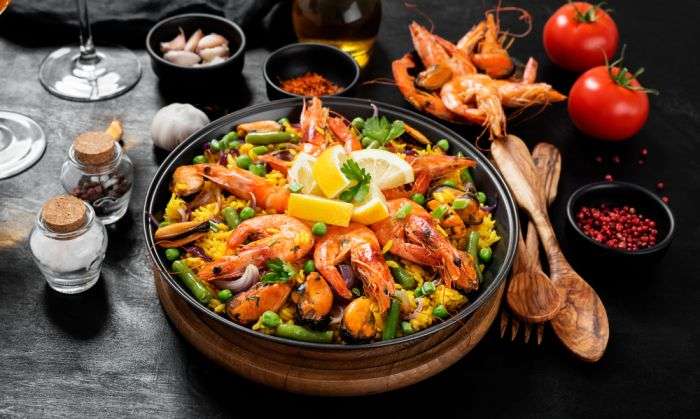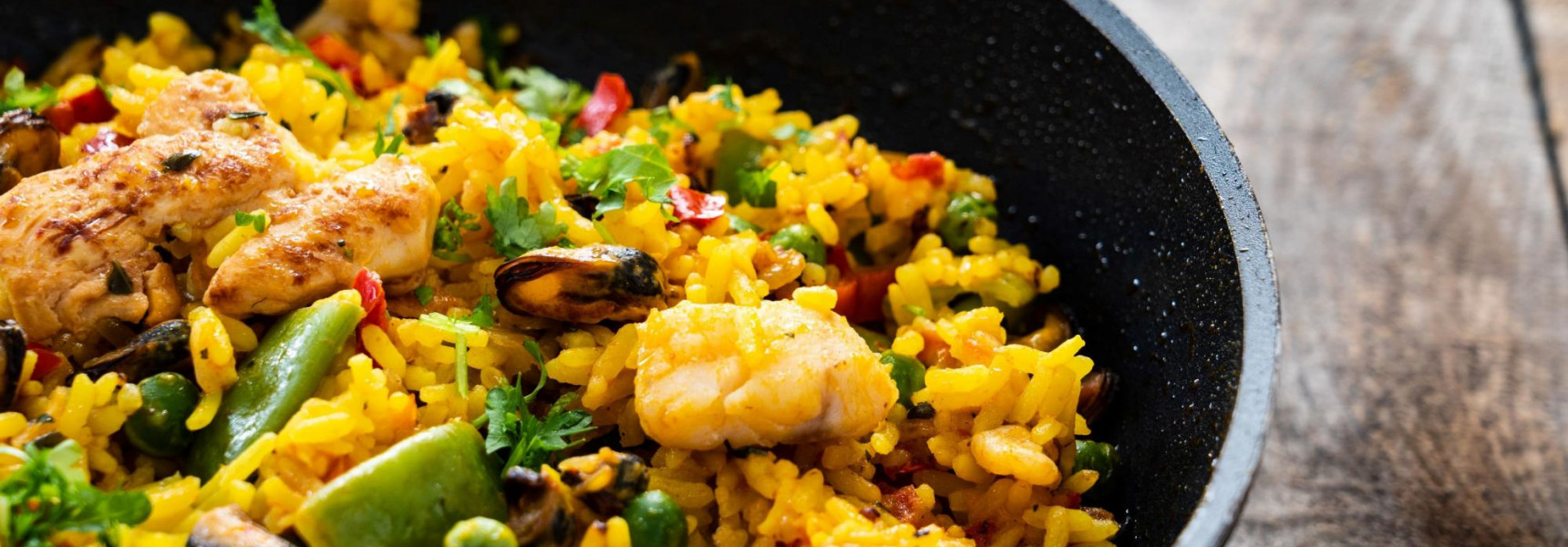Food Experiences
Barcelona
Published: 02 Jun 2022
Paella is one of Spain's most popular dishes, but its ingredients vary dramatically from region to region. What makes the paella in Barcelona so different, and how can you be sure to sample an authentic Catalonian paella? In this article, we'll explain what to look out for as you hit the streets of Catalonia in search of this iconic rice dish. Alternatively, why not book one of our many food and drink experiences in Barcelona ahead of your travels?
What are the origins of paella?
Paella originated in the 18th century in Valencia, a port city that lies south of Barcelona, where the Turia River meets the Mediterranean Sea. It is thought that paella emerged from the practice of simply throwing leftovers into a large frying pan over an open fire to create a cheap and tasty meal that could be shared amongst a large group. It wasn't until the 19th century that the term "paella" was used to describe the dish.
The authentic Valencian version of paella combines white rice, meat - often rabbit, chicken, duck, snails or a combination of these ingredients - green vegetables and beans. It is cooked with olive oil and seasoned with saffron, tomato, salt, and often garlic and paprika. This original version does not contain seafood, despite most of us picturing the dish to be a combination of meat and seafood with rice. According to Valencian paella purists, a paella made with seafood isn't a paella at all. However, as the dish grew in popularity across Spain throughout the 19th century, different regions began to put their own spin on it using whatever local ingredients they had to hand, and this often included seafood.

How is paella different in Barcelona?
Barcelona is the capital of the Catalonia region which is renowned for its ability to blend sea and mountain in its cuisine. Fresh delicious seafood from the Mediterranean coast is frequently combined with produce from the fertile countryside. In the context of paella, this means that seafood and meat are frequently combined. Prawns, mussels, squid, crayfish and clams are common, and you may often come across chicken, sausage, and Iberian ham in paella dishes.
You can also find plenty of rice dishes in Barcelona which share similarities with paella but go by different names. Look out for "arroz" dishes on menus, which tend to utilise a similar cooking method as paella - throwing ingredients into a pan with rice and stock - but with different ingredients and textures. "Arroz caldoso", which translates as "soupy rice", and "arroz melosa", meaning "creamy rice" are hearty dishes that often include luxurious lobster. "Arroz negre" - "black rice" is cooked in a paella pan with squid ink which turns the rice jet black and imparts a rich, deep flavour that blends well with aioli (garlic mayonnaise) which is usually served on the side.
"Fideuà" is another alternative to paella which is definitely worth a try. It contains noodles, much like short strings of spaghetti, instead of rice. If an arroz dish mentions the word "socarrat", you can assume it to be prepared very much like paella - cooked on a frying pan until a crunchy, toasty crust of caramelised rice forms at the bottom of the pan. This socarrat is the most delicious and prized part of a paella dish.
Is paella common in Barcelona?
You'll find paella in very many restaurants in Barcelona, but be wary of cheap, ready-made varieties that lower quality restaurants will buy frozen and simply heat up to serve. Paella takes some time to cook, but the joy of it is in the use of whatever fresh ingredients are available on any given day. Restaurants in the most popular tourist hot spots tend to cut corners and are unlikely to prepare fresh and authentic Catalonian paella.
Las Ramblas, a huge boulevard that runs through the heart of Barcelona, is thriving with tourists, but it is generally advised to avoid the eateries here. Instead, venture off the beaten track and hunt out smaller and quieter restaurants where locals are more likely to be seen. Here, you are far more likely to find authentic Catalonian paella and arroz dishes made fresh with local ingredients.

What is Barcelona's most famous food?
Although paella in Barcelona is no doubt delicious, it isn't a dish that is connected specifically with the city. If you're looking to try food that the city is famous for, look out for these dishes.
Bacalla
Bacalla is cod which is salted in order to preserve it, and it's eaten widely in Catalonia. You'll find it cooked in a variety of ways. Look out for "esqueixada de bacallà" in which the cod is shredded and served with chopped tomatoes, onions, red peppers, black olives and plenty of olive oil to create a light and refreshing summer dish. For something heartier, try "bacallà amb samfaina" which has a rich, tomato sauce that contains a mixture of chopped vegetables, onion and garlic that is reminiscent of ratatouille.
Botifarra negra
This blood sausage is a popular cured meat in Catalonia which can be eaten just as it is along with other savoury treats such as "jamon" (cured ham), "fuet" (cured pork meat sausages), "pa amb tomàquet" (crusty bread scraped with garlic and fresh tomatoes) and olives. It's also often included in sauces and stews to add depth of flavour. You'll find it in "faves a la Catalana", a rich and filling dish of fava beans cooked in an earthenware pot.
Canelons
An adaptation of Italian cannelloni, canelons are tubes of pasta filled with stewed or roasted meat and topped with a white sauce. This is a traditional dish often served at home on 26th December to use up any Christmas dinner leftovers. There are lots of variations to try, including duck, veal, chicken and pork, and you're bound to find plenty of restaurants serving them up in Barcelona.
Find authentic paella in Barcelona with a food tour
Barcelona is one of the best places in the world to eat, however, it can often be difficult to find authentic eateries. Especially in the city centre where many places cater for the tourist marketplace. Yet, with tabl. you can discover the very best paella in Catalonia with our Barcelona food and drink experiences.

Keep Exploring
Find more amazing tabl. experiences to visit.
